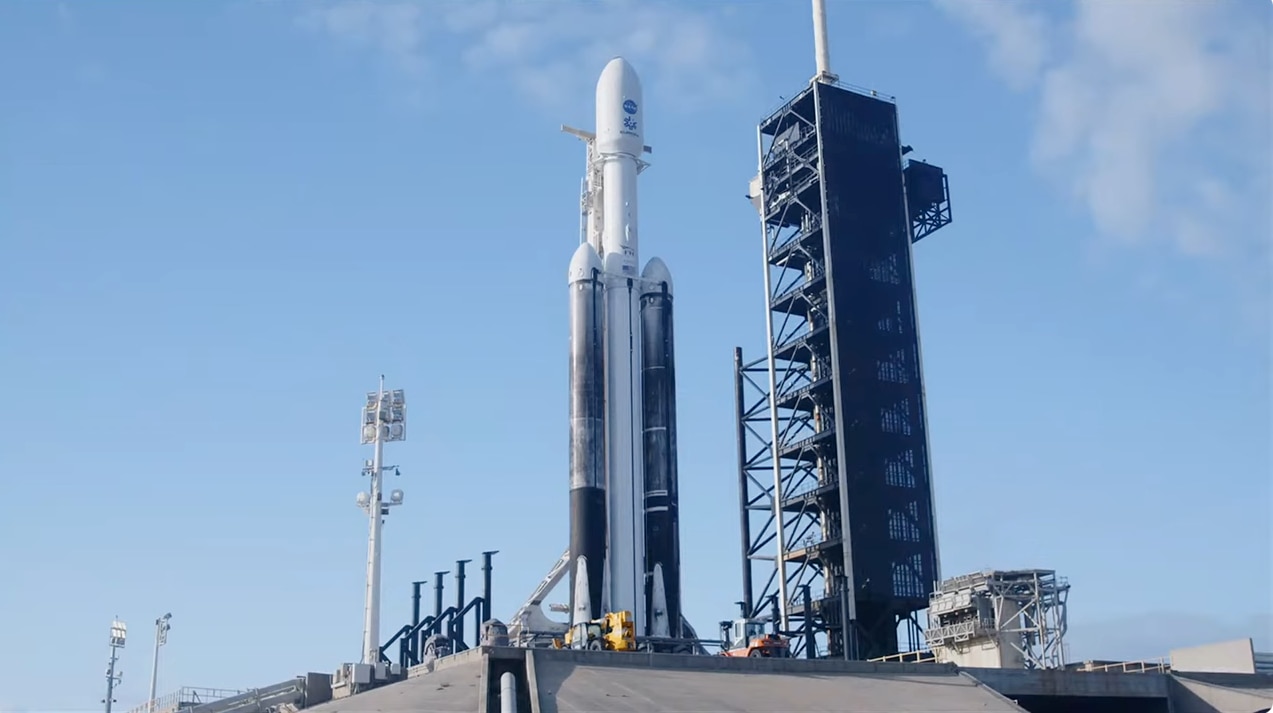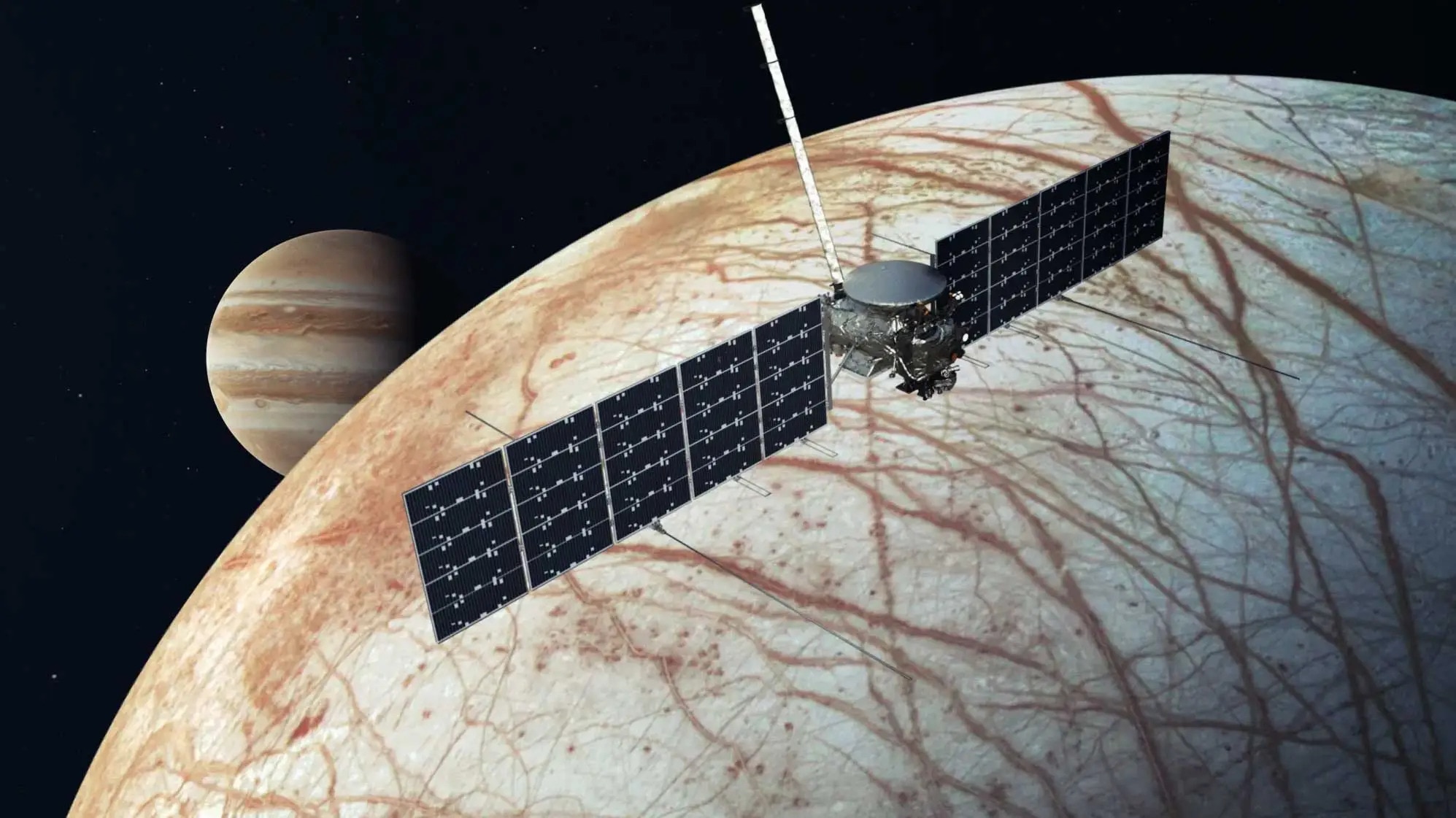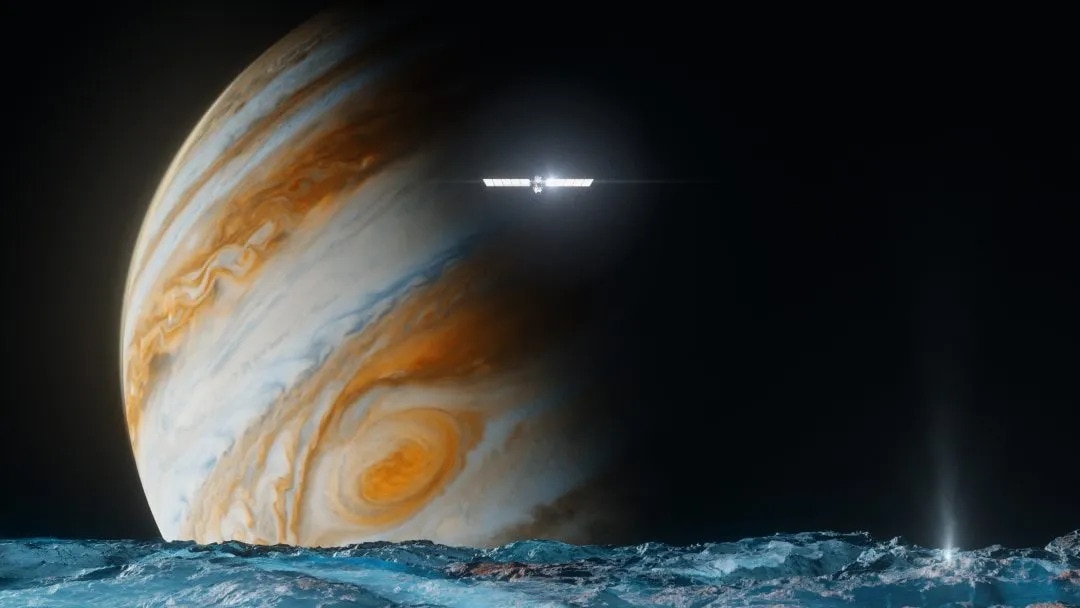Europa Clipper mission to 'one of the most promising places to look for life beyond Earth' set for lift-off

The Europa Clipper on the launch pad, aboard a SpaceX Falcon Heavy rocket.
In short:
An imposing NASA probe, scheduled to lift off as Australia sleeps, might take the first real step toward finding out if anywhere else in our solar system could support life.
Jupiter's moon Europa may have a large ocean beneath its surface and is considered one of the most promising places to look for life beyond Earth.
What's next?
The probe will travel 2.9 billion kilometres on its journey to Jupiter, with arrival expected in April 2030.
Is there anywhere else in our solar system that could support life?
An imposing NASA probe due to lift off as Australia sleeps tonight might take the first real step toward finding out.
The Europa Clipper probe will lift off from Cape Canaveral, Florida aboard a SpaceX Falcon Heavy rocket at 12:06pm on Monday local time, NASA said. That is 3:06am on Tuesday AEST, or 4:06am AEDT.
The five-and-a-half-year-long Clipper mission will allow the US space agency to uncover new details about the Jupiter-orbiting moon Europa — which scientists believe could hold an ocean of liquid water beneath its icy surface.
"Europa is one of the most promising places to look for life beyond Earth," NASA official Gina DiBraccio said at a news conference last month.
The mission will not look directly for signs of life but will instead look to answer the question: Does Europa contain the ingredients that would allow it to thrive?
If it does, another mission would then have to make the journey to try and detect it.
"It's a chance for us to explore not a world that might have been habitable billions of years ago," Europa Clipper program scientist Curt Niebur told reporters last month, "but a world that might be habitable today, right now."
Largest NASA probe for planetary exploration

In this artist's concept, the Europa Clipper is seen over Europa with Jupiter in the distance.
Europa has been known to scientists since 1610 and was first photographed by Voyager probes in 1979.
The images revealed mysterious reddish lines crisscrossing the moon's surface.
The next probe to reach Jupiter's icy moon was NASA's Galileo probe in the 1990s, which found it was highly likely that the moon was home to an ocean.
This time, the Europa Clipper probe will carry a host of sophisticated instruments, including cameras, a spectrograph, radar and a magnetometer to measure its magnetic forces.
The probe is the largest ever designed by NASA for interplanetary exploration.
It is 30 metres wide when its immense solar panels — designed to capture the weak light that reaches Jupiter — are fully extended.
Europa arrival expected April 2030
The probe will travel 2.9 billion kilometres on its journey to Jupiter, with arrival expected in April 2030.
The main mission will then last another four years.
The probe will make 49 close flybys over Europa, coming as close as 25 kilometres above the surface.
It will be subjected to intense radiation — the equivalent of several million chest X-rays on each pass.
The mission will look to determine the structure and composition of Europa's icy surface, its depth and even the salinity of its ocean, as well as the way the two interact — to find out, for example, if water rises to the surface in places.
The aim is to understand whether Europa is home to the three necessary ingredients for life: water, energy and certain chemical compounds.
Deputy project scientist Bonnie Buratti explained that if the moon fostered these conditions, life could be found in the ocean in the form of primitive bacteria.
But the bacteria would likely be too deep for the Europa Clipper to see.
What if the moon is desolate?

This is an artist's illustration of Europa Clipper above the moon's surface, in front of Jupiter.
Some 4,000 people have been working on the $US5.2 billion ($7.72 billion) mission for around a decade.
NASA says the investment is justified by the importance of the data that will be collected.
But what if Europa is not habitable after all?
"That also opens up a whole wealth of questions: Why did we think this? And why is it not there?" Nikki Fox, an associate administrator at NASA, said.
If our solar system turns out to be home to two habitable worlds (Europa and Earth), "think of what that means when you extend that result to the billions and billions of other solar systems in this galaxy," Dr Niebur said.
"Just the habitability question … opens up a huge new paradigm for searching for life in the galaxy."
The Europa Clipper will operate at the same time as the European Space Agency's (ESA) Juice probe, which will study two other moons of Jupiter — Ganymede and Callisto.
AFP/ABC
By:https://www.abc.net.au/news/2024-10-14/nasa-mission-to-find-life-on-jupiter-moon-ready-for-lift-off/104471608(责任编辑:admin)
下一篇:Who is Vem Miller, the man accused of bringing a loaded gun and fake ID to a Donald Trump rally at Coachella?
 Socceroos rescue a point
Socceroos rescue a point  Wallabies thrash Wales 52
Wallabies thrash Wales 52 Jake Paul beats Mike Tyso
Jake Paul beats Mike Tyso Live updates: England vs
Live updates: England vs  US election 2024: Donald
US election 2024: Donald  US election live: Kamala
US election live: Kamala
- ·North Korea's latest weapon agains
- ·Hezbollah says Israel 'cannot impo
- ·Inside the rise of US oligarchs and how
- ·Thailand's worst suspected serial
- ·Tabi shoes are turning heads from Holly
- ·FBI arrests Florida man planning attack
- ·Illegal immigrant gets life sentence fo
- ·Bibles, water, watches and sneakers: Do
- ·North Korea's latest weapon against
- ·Hezbollah says Israel 'cannot impose
- ·Inside the rise of US oligarchs and how i
- ·Thailand's worst suspected serial ki
- ·Tabi shoes are turning heads from Hollywo
- ·FBI arrests Florida man planning attack o
- ·Illegal immigrant gets life sentence for
- ·Bibles, water, watches and sneakers: Dona
- ·US to give Kyiv anti-personnel landmines
- ·An arrest warrant for Benjamin Netanyahu
- ·One of Vietnam's high-profile politi
- ·Shanghai Walmart Attack: A Man Randomly S
- ·South Korean police officers jailed over
- ·Cambodia publicly shames maid deported af
- ·North Korea to use all forces including n
- ·Philippines condemns China attack of Viet
- ·US adds 2 more Chinese companies to Uyghu
- ·North Korean defector steals South Korean
- ·Malaysia deports Cambodian worker for cal
- ·Rebels battle for Myanmar junta’s weste

